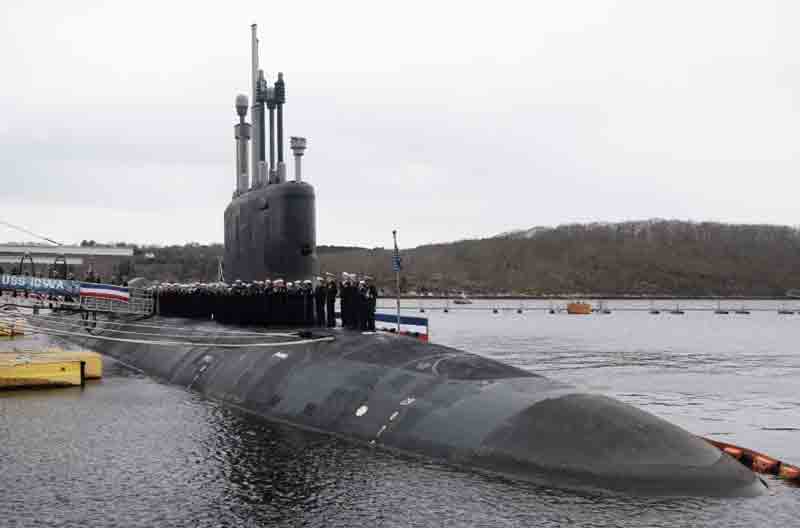The US Navy officially commissioned its 24th Virginia-class fast-attack submarine, USS Iowa (SSN 797), in a formal ceremony held on April 5, 2025, at Naval Submarine Base New London in Groton, Connecticut. This event marks a significant step forward in the ongoing enhancement and expansion of the U.S. undersea fleet, particularly as global naval powers intensify their efforts to establish dominance in underwater warfare.
The commissioning of the USS Iowa highlights the U.S. Navy’s dedication to maintaining undersea superiority in the face of increasing competition from rival navies, notably China and Russia. With 24 Virginia-class submarines now operational and additional units in development, the U.S. boasts the largest and most advanced attack submarine fleet in the world. This growth is particularly vital as China rapidly expands its submarine capabilities, which are currently estimated to exceed 60 vessels, including approximately a dozen that are nuclear-powered. China’s latest Type 093 and forthcoming Type 095 nuclear attack submarines reflect its ambitions, although they still fall short of U.S. standards in terms of acoustic stealth, sensor technology, and global operational reach.
Conversely, Russia maintains a smaller but highly effective submarine fleet. Its Yasen-class nuclear-powered attack submarines, such as the Kazan and Novosibirsk, are equipped with advanced Kalibr and Oniks cruise missiles, and may soon incorporate hypersonic weapons. While the Yasen-class can compete with some U.S. capabilities in terms of firepower and speed, its overall fleet size is constrained by budget limitations and slower production rates. As of 2025, Russia operates fewer than 10 of the latest generation of nuclear-powered attack submarines, rendering its undersea force powerful yet less numerous and less capable of global deployment compared to its American equivalent.
The Virginia-class submarines, including the recently commissioned USS Iowa, form the core of the United States’ contemporary undersea warfare capabilities. These vessels integrate cutting-edge stealth technology, sophisticated intelligence-gathering systems, and versatile multi-mission functionality, allowing them to excel in both deep-sea and coastal combat scenarios. Measuring 377 feet in length and capable of exceeding speeds of 25 knots while submerged, the USS Iowa is powered by a nuclear reactor, enabling it to operate for over 30 years without the need for refueling. Its arsenal features 12 vertical launch tubes for Tomahawk cruise missiles, four torpedo tubes for Mk-48 advanced torpedoes, and the capability to deploy unmanned undersea vehicles and special operations teams. The submarine’s advanced sonar systems and photonic masts significantly enhance situational awareness while preserving stealth in contested waters.
As the sixth submarine constructed under Block IV, the USS Iowa includes enhancements designed to minimize major maintenance periods and boost deployment readiness. These upgrades allow the submarine to undertake more missions with improved operational efficiency, a vital asset as undersea threats continue to develop.
Commander Gregory Coy, the commanding officer of the USS Iowa, highlighted the vessel’s readiness for frontline operations, stating, “Today, we become the ‘USS’ Iowa, and I intend to take her to the frontline, continuing the Navy’s overwhelming display of undersea dominance and lethality.” Secretary of the Navy Carlos Del Toro reinforced the strategic importance of such platforms, emphasizing that submarines like the Iowa are crucial for deterring aggression and projecting power on a global scale.
Looking to the future, the U.S. Navy intends to expand its fleet of fast-attack submarines to a minimum of 66 vessels while simultaneously progressing with the next-generation SSN(X) program to maintain its dominance into the 2030s and beyond. In contrast, neither China nor Russia is expected to rival the United States in terms of the overall quality, quantity, and global operational reach of its fast-attack submarine fleet.
Since the launch of the first Virginia-class submarine, USS Virginia (SSN 774), on October 23, 2004, this class has grown steadily through four production blocks. Blocks I and II established the technological groundwork, while Block III brought significant design innovations, including the Virginia Payload Tubes. Block IV, which features the USS Iowa, focuses on longer deployment capabilities and reduced maintenance needs. As of April 2025, the active fleet of Virginia-class submarines in the U.S. Navy comprises:
– Block I: USS Virginia (SSN-774), USS Texas (SSN-775), USS Hawaii (SSN-776), USS North Carolina (SSN-777)
– Block II: USS New Hampshire (SSN-778), USS New Mexico (SSN-779), USS Missouri (SSN-780), USS California (SSN-781), USS Mississippi (SSN-782), USS Minnesota (SSN-783)
– Block III: USS North Dakota (SSN-784), USS John Warner (SSN-785), USS Illinois (SSN-786), USS Washington (SSN-787), USS Colorado (SSN-788), USS Indiana (SSN-789), USS South Dakota (SSN-790), USS Delaware (SSN-791)
– Block IV: USS Vermont (SSN-792), USS Oregon (SSN-793), USS Montana (SSN-794), USS Hyman G. Rickover (SSN-795), USS New Jersey (SSN-796), USS Iowa (SSN-797)
Discover more from Defence Talks | Defense News Hub, Military Updates, Security Insights
Subscribe to get the latest posts sent to your email.





